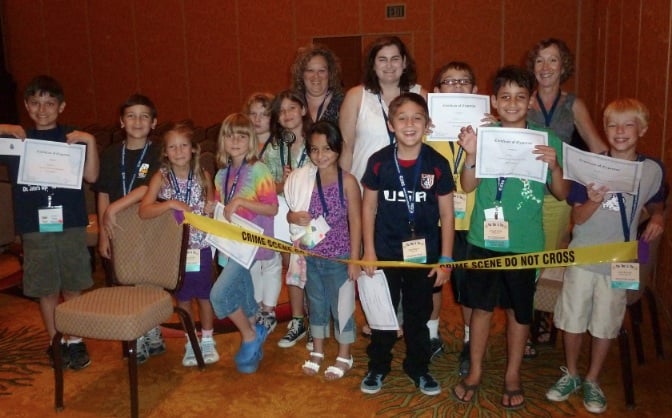Crime or No Crime
 |
About the presenter: Rita Thurman, CCC--BRS-FD M.S., degree in Communication Disorders from Utah State University, has worked in the schools and in clinical settings in Utah, Idaho, Illinois and North Carolina. She has been in private practice in Raleigh, North Carolina since 1985 focusing on the evaluation and treatment of children, teens and adults who stutter. Ms. Thurman has presented workshops on fluency disorders, is a National Stuttering Association Chapter leader, coordinates a Parent-Child Stuttering Information Group and sponsors an annual Friend's Workshop in North Carolina. |
Crime or No Crime
by Rita Thurman
from North Carolina, USA
Developing procedures to allow children who stutter to be an advocate for themselves is an important part of treatment. Children need a format to talk about their stuttering, better understand their feelings about stuttering and develop strategies to react to their listeners. Just as important, they need to have fun doing it! Adding the "fun" component allows the child to develop a positive attitude about communication.
As described by Murphy, Yaruss and Quesal (Journal of Fluency Disorders Volume 32, Issue 2, 2007, Pages 121-138 ) the therapy process must include a way for "desensitization to stuttering, cognitive restructuring, self-acceptance, (and) purposeful self-disclosure." The activity "Crime or No Crime" provides for these opportunities.
This is a group activity that I use for children ages 7-12 and was presented as a children's work shop at the 2011 NSA conference. It utilizes a mock trial format as a fun way to inform children about stuttering and enable them explore their feelings and reactions to their own stuttering. The children play the role of "judge", "accused", "attorney" and "jury". The "accused" (a younger child) is supported by an "attorney" (an older child and mentor, who helps him/her formulate his/her defense). The judge helps the jury (remaining children) deliver the verdict. After being given his/her "accusation", the accused and attorney explain why it is not a crime (e.g. stuttering during a class presentation) and why they should be found "not guilty". Participants are given the opportunity to play each role.

I have done the activity with as few as two other children; one functions as the judge and one the accused. The therapist can play the role of attorney and offer advice to advocate his/her position.
The children at NSA reacted positively to the activity. Although, their favorite part may have been slamming the gavel (available from: Amazon.com), receiving a strip of Crime Scene Tape (a necessity of any therapy room and also available from: Amazon.com) and getting finger printed (any stamp pad will work.)
My favorite quotes from the participates were: "Stuttering is not a crime, it's just another way of talking.", "Everyone gets nervous when you give a class presentation, sometimes I stutter more when I do a report in front of the class.", and my favorite: "This activity was the most fun that I had so far at the conference."
Addendum
Accusations
- You are accused of stuttering in class presentation.
- You are accused of cheating in a game with your speech teacher.
- You are accused of stuttering while answering a question in class.
- You are accused of stuttering while ordering in a restaurant.
- You are accused of stuttering on the phone when your grandma called.
- You are accused of stuttering while telling a joke in the lunchroom.
- You are accused of stuttering when reading in front of the class.
- You are accused of stuttering while talking to the principal.
- You are accused of stuttering when you asked for directions at the mall.
- You are accused of throwing a rock at your sister's/brother's head.
- You are accused of hitting someone in the eye with a boomerang.
- You are accused of giving your brother the flu.
Procedures - Varied depending on the number of children involved.
- The judge reads the crime.
- The accused states why he/she thinks it is not (or is) a crime.
If not a crime: must explain why
If it is a crime: apologize and suggest consequence (e.g. hitting your sister.) - The defending attorney offers comments.
- The jury states whether or not they think the accused is guilty or not guilty.
- The judge states his verdict.
- Everyone rotates to a new role and we start back over with #1.

